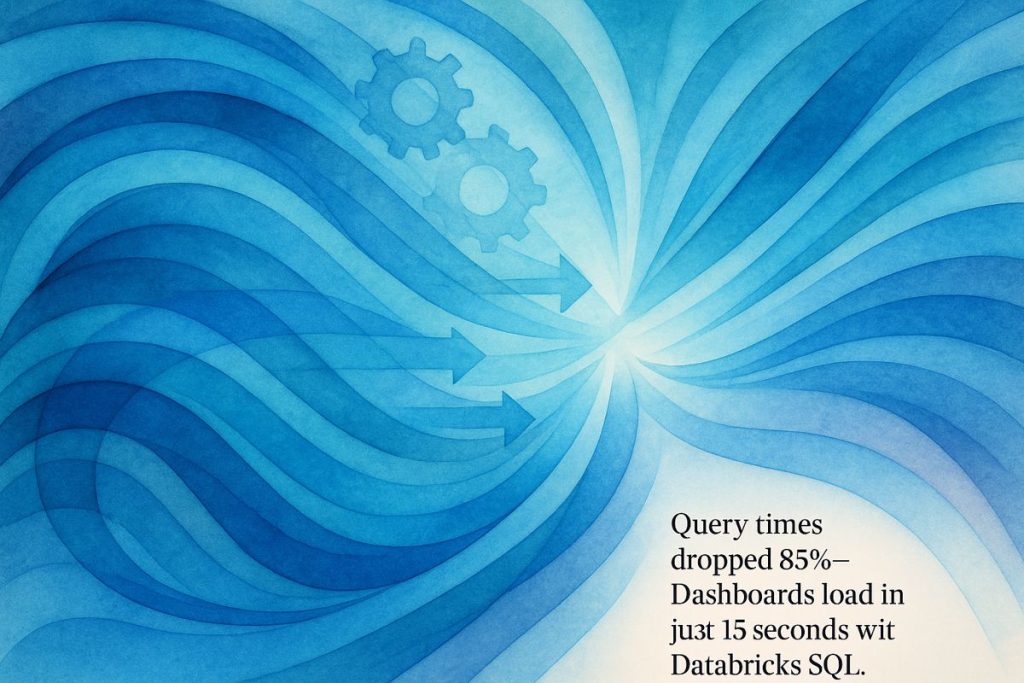Databricks SQL just got a lot faster and smarter. With Predictive Query Execution, it can change its plans on the fly, making dashboards load super quickly—sometimes five times faster than before. The new Photon Shuffle tech lets data zip around efficiently, like a jazz band playing in perfect sync. Users don’t have to do anything; all these upgrades happen automatically, making things smoother and cheaper. On top of that, everything stays organized and secure with Unity Catalog, so business teams always see the same, trusted numbers.
What are the latest performance improvements in Databricks SQL?
Databricks SQL now features Predictive Query Execution (PQE) for real-time plan optimization and Photon Vectorized Shuffle for faster, more efficient data processing. These innovations deliver up to 5x faster queries, 85% lower latency, and seamless, automatic upgrades—enhancing both speed and reliability for users.
The Art of Speed: Where Queries Learn to Dance
It’s not every day you wake up, open your laptop (still smelling of yesterday’s cold brew), and discover your dashboards are loading in 15 seconds instead of their usual century. But, as of late, that’s par for the course with Databricks SQL—whose performance leap since 2022 feels less like iterative software engineering and more like a magician’s sleight of hand. The numbers are hardly speculative: a fivefold acceleration in real-world customer workloads over three years, a recent 25% extra nudge (yes, I checked the fine print on their blog), and—my favorite—the 85% latency drop that makes old load times look like dial-up’s ghost.
You don’t even have to lift a finger. These upgrades stealthily roll out across serverless SQL warehouses, like elves in the night. No configuration fiddling, no invoice surprises. That kind of invisible, frictionless improvement—well, it’s as satisfying as popping bubble wrap.
Was I skeptical at first? Naturally. There’s a whiff of “too good to be true” about any claim of dashboard alchemy, especially when I remember the time I spent an hour tuning a single Spark query only to see negligible gains. But here, Databricks seems to have found the right levers.
Inside the Black Box: PQE and the Photon Shuffle
Let’s talk about what’s actually under the hood. Predictive Query Execution (PQE) isn’t just a mouthful—it’s a paradigm shift. Traditional adaptive query optimization, à la Apache Spark, waits politely for a query stage to finish before poking at its plan. PQE barges in mid-dance, monitoring active tasks, sniffing out signs of data skew or the ominous scent of a looming memory spill. It doesn’t just react; it predicts, recalibrates, and rewrites execution plans as the wind changes.
Imagine a chess grandmaster who not only sees ten moves ahead but changes strategy mid-game if you so much as twitch. PQE does this in real time, which gives big, hairy enterprise workloads the kind of stability usually reserved for Swiss trains. The only catch? Sometimes, for a split second, I can feel my brain lag behind the algorithm.
The sound of it? If you listen closely, a server room hums differently when Photon’s at play—less of a grind, more of a purr. Is this over-romanticizing it? Maybe. But after years spent babysitting sluggish shuffle stages, a little poetic license feels earned.
Metrics, AI, and That Elusive Source of Truth
Of course, if all this speed is just chaos, it’s not much use. Enter Unity Catalog metric views—a system for pinning down business metrics like butterflies in a glass case. Define once, govern centrally, and every dashboard, dbt model, or Fivetran pipeline pulls from the same well. I once stitched together KPIs from three departments, only to realize each was using a subtly different definition of “active user.” The confusion! Metric views would have saved me from that Kafkaesque mess.
Meanwhile, AI is everywhere, threading through Databricks SQL like a curious cat. Whether it’s AI-assisted query suggestions or predictive optimization of data statistics, the result is a consistent 22% average improvement in performance. At first, I worried that “AI-driven” meant inscrutable black boxes, but the profiling and monitoring tools bake in transparency. You can see what’s happening, poke at slow queries, and—if you’re stubborn like me—try to out-optimize the AI (spoiler: the AI usually wins now).
For those keeping track, you’ll get not just faster queries but a plush SQL editor, query snippets for those “I’ve written this 50 times” moments, and a query history so detailed you might feel a pang of nostalgia looking back at your old, clumsy attempts.
Admittedly, a bit of me misses the days of manual tuning—there’s a tactile satisfaction to it, like working with clay. But honestly? Life moves on.
The Platform Play: Governance, Cost, and Integration
Speed is intoxicating, but governance is the morning after. Unity Catalog closes the loop with centralized access, robust audit logs, and lineage tracing that would make even a Sarbanes-Oxley consultant nod approvingly. In an era of GDPR, HIPAA, and a half-dozen other acronyms, that’s more than a nice-to-have.
Databricks keeps the concurrency/cost ratio almost linear as data scales (they claim), and they’re toying with advanced compression and dynamic downscaling in private preview. Watch this space. I’ve been burned before by “cost optimization” features that mysteriously ballooned my bill—so I’m cautious
